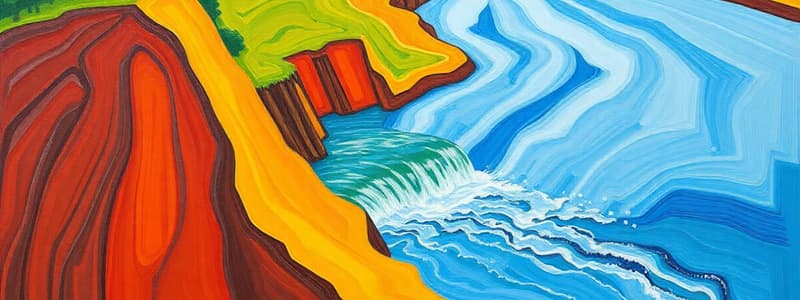Podcast
Questions and Answers
What are levees?
What are levees?
Levees are natural landforms in the lower curve as a result of deposition and sediment aggregation They stand as ridges of sediment along the banks of a river.
What happens when river discharge exceeds bankfull level?
What happens when river discharge exceeds bankfull level?
The river flows & water spills out laterally across the floodplain. As the wetted perimeter increases, friction increases, resulting in a lower level of river efficiency and velocity.
What is deposition?
What is deposition?
As river energy decreases, river loses competence, and larger heavier bluff sized particles are deposited first along the bends of a river channel. Deposited particles become increasingly smaller with distance from the channel & the smallest particles are the bluff line. There is a gradation evident in terms of particle size.
What are raised banks?
What are raised banks?
Flashcards
River Levees
River Levees
Natural embankments along river banks formed by sediment deposits.
River Discharge
River Discharge
Amount of water flowing in a river.
Bankfull Level
Bankfull Level
River level where the water just fills the river channel.
River Flooding
River Flooding
Signup and view all the flashcards
Deposition
Deposition
Signup and view all the flashcards
River Efficiency
River Efficiency
Signup and view all the flashcards
River Velocity
River Velocity
Signup and view all the flashcards
Sediment Competence
Sediment Competence
Signup and view all the flashcards
Floodplain
Floodplain
Signup and view all the flashcards
Repeated Flooding
Repeated Flooding
Signup and view all the flashcards
Study Notes
Levees
- Levees are natural landforms in the lower course of a river.
- They are formed by the deposition of sediment along the riverbanks.
- They form ridges of sediment.
River Discharge and Flooding
- Flooding occurs when river discharge exceeds bankfull level.
- Lateral erosion of the riverbanks occurs.
- This leads to a lowered river efficiency and an increase in velocity.
- Water spills out into the flood plain.
- Friction increases.
Deposition
- As river energy decreases, the river loses competence.
- Larger, heavier particles are deposited first along the riverbanks.
- As the distance from the channel increases, smaller particles are deposited.
- This creates a gradation in particle size, with the largest particles closest to the river channel.
- Gradual deposition results in the formation of levees.
Repetition of Flooding and Deposition
- Repeated flooding and deposition events result in the formation of multiple levees along the river channel.
Studying That Suits You
Use AI to generate personalized quizzes and flashcards to suit your learning preferences.




